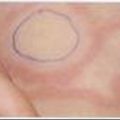11.6 Acute leukaemia
Introduction
The leukaemias are a group of diseases characterised by the clonal proliferation of malignant immature white blood cell precursors. They differ in the lineage and degree of differentiation of cells involved, being broadly divided into two groups: lymphoid and myeloid. These two categories are further subdivided into an acute form that progresses more rapidly than the chronic disease, which is relatively indolent. Preconceptional germ cell and postnatal environmental exposure to electromagnetic radiation and carcinogens may play a role,1–3 with higher risk in children with congenital neutropenia, Down’s syndrome and Fanconi anaemia.4 Previous chemotherapy and radiotherapy are associated with increased risk of a secondary malignancy. Acute lymphoblastic leukaemia (ALL) comprises four-fifths of childhood leukaemia,4 with acute myeloid leukaemia (AML) and chronic myeloid leukaemia (CML) accounting for 15% and 2%.5 Together they account for one-third of all malignancies in children under 15 years old. Although children of all ages are affected, the peak incidence is between 2 and 6 years.
Classification
Leukaemogenesis represents clonal proliferation of white blood cells arrested at various stages of differentiation, lending itself to diagnostic and prognostic classification based on the cell line affected, degree of differentiation, immunophenotyping, cell receptor, cell antigen and chromosomal studies. Classification of leukaemia is complex, with the French–American–British (FAB) categories being useful for AML and immunotyping better suiting ALL.4,5
Prognosis
The cure rate for ALL is 80%,4 compared with only 30–50% for AML,5 depending on whether adverse prognostic factors are present. Poor-risk AML has a dismal outlook, with less than 20% achieving long-term remission. Adverse prognostic factors include age (ages <1, >10 years), certain chromosomal translocations (such as t(4;11) in infant ALL), a very high-presenting leucocyte count and poor response to first-course treatment. Although the cumulative risk of ALL relapse is 15–20%, the risk of developing second malignancies after successful treatment is low.4,5
Management
Controversies and future directions
 The future management of leukaemia will be influenced by new and improved risk stratified therapy to improve outcomes and minimise adverse effects. High-risk patients could be identified by molecular analysis, in vitro pharmacodynamic, pharmacogenetic, pharmacogenomic and drug resistance studies to receive more intensive and targeted therapy. 6–9
The future management of leukaemia will be influenced by new and improved risk stratified therapy to improve outcomes and minimise adverse effects. High-risk patients could be identified by molecular analysis, in vitro pharmacodynamic, pharmacogenetic, pharmacogenomic and drug resistance studies to receive more intensive and targeted therapy. 6–9 The increasing use of severely myelotoxic chemotherapy and unrelated bone-marrow transplantation has improved prognosis in acute leukaemia but has given rise to complications related to marrow suppression.
The increasing use of severely myelotoxic chemotherapy and unrelated bone-marrow transplantation has improved prognosis in acute leukaemia but has given rise to complications related to marrow suppression. Biological (e.g. monoclonal antibodies) rather than cytotoxic agents and agents with better specificity for leukaemic cells result in less ‘collateral damage’10 Gene therapy, although promising, remains experimental and clinically unproven.11
Biological (e.g. monoclonal antibodies) rather than cytotoxic agents and agents with better specificity for leukaemic cells result in less ‘collateral damage’10 Gene therapy, although promising, remains experimental and clinically unproven.111 Schutz J., Ahlbom A. Exposure to electromagnetic fields and the risk of childhood leukaemia: a review. Radiat Prot Dosimetry. 2008;132:202-211.
2 Infante-Rivard C. Chemical risk factors and childhood leukaemia: a review of recent studies. Radiat Prot Dosimetry. 2008;132:220-227.
3 Greaves M. Infection, immune responses and the aetiology of childhood leukaemia. Nat Rev Cancer. 2006;6:193-230.
4 Smith O.P., Hann I.M. Clinical features and therapy of lymphoblastic leukemia. In: Arceci R.J., Hann I.M., Smith O.P., editors. Pediatric Hematology. 3rd ed. London: Blackwell Publishing Ltd; 2006:450-481.
5 Kean L.S., Arceci R.J., Woods W.G. Acute myeloid leukemia. In: Arceci R.J., Hann I.M., Smith O.P., editors. Pediatric Hematology. 3rd ed. London: Blackwell Publishing Ltd; 2006:360-383.
6 Zwaan C.M., Kaspers G.J.L. Possibilities for tailored and targeted therapy in paediatric acute myeloid leukaemia. Br J Haematol. 2004;127:264-279.
7 Aplenc R., Lange B. Pharmacogenetic determinants of outcome in acute lymphoblastic leukemia. Br J Haematol. 2004;125:421-434.
8 Harrison C.J. Cytogenetics of paediatric and adolescent acute lymphoblastic leukemia. Br J Haematol. 2009;144:147-156.
9 Pui C.H., Robison L.L., Look A.T. Acute lymphoblastic leukemia. Lancet. 2008;371:1030-1043.
10 Blair A., Goulden N.J., Libri N.A., et al. Immunotherapeutic strategies in acute lymphoblastic leukemia relapsing after stem cell transplantation. Blood Rev. 2005;19:289-300.
11 Brown P., Smith F.O. Molecularly targeted therapies for pediatric acute myeloid leukemia: progress to date. Paediatr Drugs. 2008;10:85-92.



